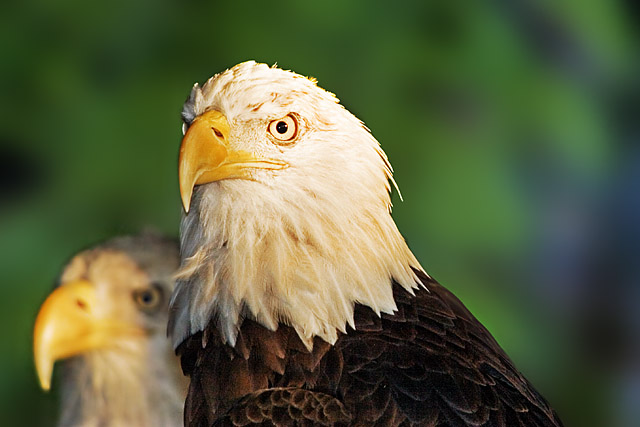Bald Spot : July 31, 2008

Image Data
File Name: 20D_39648
Model: Canon EOS 20D
Lens: Canon EF 70-200mm F/2.8L USM 2X
Date: 07.30.08 7:28pm
Focal Length: 400mm (640mm)
Shutter: 1/200 s
F-Stop: F6.3
ISO: 200
Ex Bias: -1
Program: Aperture priority
Metering Mode: Partial
Flash: On
Flash Bias: -3 EV
Flash Details: External flash, E-TTL
Focus Mode: One shot AF
File Name: 20D_39648
Model: Canon EOS 20D
Lens: Canon EF 70-200mm F/2.8L USM 2X
Date: 07.30.08 7:28pm
Focal Length: 400mm (640mm)
Shutter: 1/200 s
F-Stop: F6.3
ISO: 200
Ex Bias: -1
Program: Aperture priority
Metering Mode: Partial
Flash: On
Flash Bias: -3 EV
Flash Details: External flash, E-TTL
Focus Mode: One shot AF
This sea eagle gets both its common and scientific names from the distinctive appearance of the adult's head. Bald is derived from the word piebald, and refers to the white head and tail feathers and their contrast with the darker body. The scientific name (Haliaeetus leucocephalus) is derived from Haliaeetus, New Latin for "sea eagle".
The Bald Eagle prefers habitats near seacoasts, rivers, large lakes, and other large bodies of open water with an abundance of fish. They are extremely sensitive to human activity, and occur most commonly in areas free of human disturbance.
The Bald Eagle is a powerful flier,and soars on thermal convection currents. It reaches speeds of 35–44 mph when gliding and flapping, and about 30mph while carrying fish.
The Bald Eagle prefers habitats near seacoasts, rivers, large lakes, and other large bodies of open water with an abundance of fish. They are extremely sensitive to human activity, and occur most commonly in areas free of human disturbance.
The Bald Eagle is a powerful flier,and soars on thermal convection currents. It reaches speeds of 35–44 mph when gliding and flapping, and about 30mph while carrying fish.















 Subscribe
Subscribe


